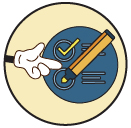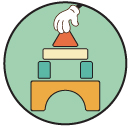This is part of the ADA Title 2 toolkit, a resource to help public entities start building digital accessibility strategies.
These are tasks and examples to start building your website content accessibility strategy. It is broken into three parts:
- Identify environment
- Put processes in place
- Fix existing content
 Identify environment
Identify environment
Goal: Discover content you have, the current state, and any opportunities you can build on.
Tasks
A task or process Pope Tech does for you or supports is marked with **.
- Inventory websites.**
- Find who edits the website content.
- Find who edits the website code.
- Identify any website policies about accessibility or content expectations that already exist.
- Learn about the current process for updating website content for the people you identified as people who update the content and code.
- Learn about any other processes in place for updating content (training, quality assurance)
- Determine if any monetary, technological, time, or people resources currently exist for updating existing content and maintaining new content going forward.
- Find potential opportunities to build on.
Potential opportunities
Example opportunities you might find:
- What websites or user flows get 80% (or most) of the views? Prioritize these first.
- Websites and website templates already being updated.
- Departments or teams that are willing or excited about the work.
- Processes or people that are already doing things well.
 Put processes in place
Put processes in place
Goal: Build a digital accessibility strategy that maintains your content’s accessibility.
Tasks
A task or process Pope Tech does for you or supports is marked with **.
- Leadership buy-in
- Meet with leadership to inform them of the current state, needs, goals, and get support for policies or resources (if needed).
- Follow up with leadership regularly.
- New process for maintaining accessibility
- Define and publish new organizational policies (if needed).
- Define the new process (that includes accessibility checks) for creating new or updating web content.
- Define new processes (that include accessibility checks) for creating new or updating website HTML. There can be multiple processes depending on the size of the update.
- Create a plan to communicate the new process/policy and track adoption. This could include email campaigns, training, videos, incentives, and more.
- Create a training plan. This should include training on new processes and any tools needed.**
- Training and communication
- Make a list of people you’ll communicate with about policies, processes, training, etc. (This could include people you have already identified, stakeholders, and other supporting groups).
- Carry out the communication plan.
- Host any necessary trainings or check in with people to make sure they’ve completed training.**
- Track adoption.
- Document expectations, processes, and training requirements for new hires and share with departments or teams.
- Start regular and consistent automated and manual testing
- Create a process for when there are accessibility issues going forward. They should be documented in the same system as other non-accessibility bugs or communicated to the department or team to fix the issue quickly to stay compliant.**
- Set up automatic accessibility testing on all your websites monthly.**
- Determine a manual testing strategy and complete it yearly.**
- Make sure accessibility issues are documented and fixed regularly.**
Potential opportunities
- Depending on the size of your organization, there might be multiple leaders. Start work with leaders who are willing.
- Creating a company policy that clarifies the standard and what happens if it isn’t met can keep everyone accountable.
- Sharing wins and progress publicly could motivate different teams to be a part of the effort.
- Start small with groups who want to be part of it. Share their wins and make changes for a larger rollout.
- Training seminars that already exist you could become a part of.
Example processes for building accessibility strategies
Here are three example processes to use as a starting point:
Content editors updating websites
- Make updates in the content management system (CMS)
- Before publishing, use the WAVE extension to check content for accessibility issues.
- Fix any issues before publishing.
- Publish content.
Developers updating website HTML
Large updates to the website template could follow this process:
- In a sandbox or local environment, use the WAVE extension to check for accessibility issues.
- Perform keyboard accessibility testing.
- Zoom in on the content to check for reflow.
- Perform screen reader testing.
- Document or fix issues.
- Publish HTML.
Regular automated and manual testing process
- Run automatic testing on all websites once a month.
- Complete manual testing annually. Document or fix issues found.
- Set up automatic reports to departments or teams so they can fix any new issues.
Learn more about automated and manual testing:
 Fix existing issues
Fix existing issues
Goal: Test existing content and fix accessibility issues.
Tasks
A task or process Pope Tech does for you or supports is marked with **.
- Determine in-scope existing content.**
- Test in-scope content and find opportunities.**
- Determine who is responsible for testing and updating existing web content.
- Determine who is responsible for testing and updating the existing web template (issues in the navigation, header, footer, or any other HTML technical areas).
- Document work in the central project management system that also has non-accessibility-related tasks (if relevant). Or, create a project tracker.**
- Set goals, starting with easy wins and opportunities.
- Create a plan for escalating potential blocks and barriers.
- Schedule regular check-ins with all applicable stakeholders and contributors.
Potential opportunities
- Often, a website’s template has most of the issues. A template is the same on multiple pages, so if a developer fixes the issue once, it will fix it on all the pages that use that template.
- Easier issues in the content like alternative text, heading structure, descriptive links, etc. could be assigned to the teams or departments that manage that website.
- If an existing page is updated naturally, it removes it from the scope of existing content that needs updating.
- Existing websites, pages, or flows that receive the most views.
- Instead of going by webpage, fix the most common issues first.
Want a jump start?
Our accompanying webinar covers how to break up your accessibility efforts into more manageable pieces with real-life examples.
Start in the right direction quicker.
Our experts are here to help plan your ADA compliance strategy.
 How Pope Tech helps
How Pope Tech helps
Fixing existing issues and building an accessibility strategy that people actually adopt is difficult. It requires inventorying, training, continuous communication, planning, and tracking.
Pope Tech’s platform aims to simplify accessibility by supporting multiple parts of your accessibility strategy.

Identify your content
- Inventorying webpages
- Inventorying videos
- Inventorying PDFS
- Inventorying all Canvas course content

Prevent future issues
- Accessibility topic training for contributors
- Product training for organization
- Accessibility documentation to help people learn as they go
- Scheduled automated and manual testing
- Scheduled and automated reporting to anyone in your organization
- Easy-to-use dashboard to track progress and spot emerging issues
- User organization to make sure everyone has access to what they need

Test and fix existing issues
- Automated accessibility testing
- Guided manual testing flow
- Integrations with Jira, Asana, and email to send tasks directly to contributors
- API integrations to customize your flows
- Identifying issues with 3rd party tools
- Access to accessibility experts to answer any questions






